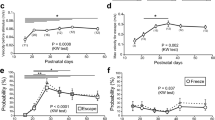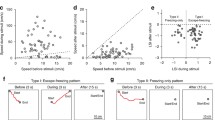Abstract
Environmental threats often trigger innate defensive responses in mammals. However, the gradual development of functional properties of these responses during the postnatal development stage remains unclear. Here, we report that looming stimulation in mice evoked flight behavior commencing at P14–16 and had fully developed by P20–24. The visual-evoked innate defensive response was not significantly altered by sensory deprivation at an early postnatal stage. Furthermore, the percentages of wide-field and horizontal cells in the superior colliculus were notably elevated at P20–24. Our findings define a developmental time window for the formation of the visual innate defense response during the early postnatal period and provide important insight into the underlying mechanism.







Similar content being viewed by others
References
Tovote P, Esposito MS, Botta P, Chaudun F, Fadok JP, Markovic M. Midbrain circuits for defensive behaviour. Nature 2016, 534: 206–212.
Ydenberg RC, Dill LM. The economics of fleeing from predators. Adv Study Behav 1986, 16: 229–249.
Fischer S, Oberhummer E, Cunha-Saraiva F, Gerber N, Taborsky B. Smell or vision? The use of different sensory modalities in predator discrimination. Behav Ecol Sociobiol 2017, 71: 1–10.
Pereira AG, Moita MA. Is there anybody out there? Neural circuits of threat detection in vertebrates. Curr Opin Neurobiol 2016, 41: 179–187.
Albano JE, Humphrey AL, Norton TT. Laminar organization of receptive-field properties in tree shrew superior colliculus. J Neurophysiol 1978, 41: 1140–1164.
McIlwain JT, Buser P. Receptive fields of single cells in the cat’s superior colliculus. Exp Brain Res 1968, 5: 314–325.
Stewart DL, Birt D, Towns LC. Visual receptive-field characteristics of superior colliculus neurons after cortical lesions in the rabbit. Vision Res 1973, 13: 1965–1977.
Fortin S, Chabli A, Dumont I, Shumikhina S, Itaya SK, Molotchnikoff S. Maturation of visual receptive field properties in the rat superior colliculus. Brain Res Dev Brain Res 1999, 112: 55–64.
Dräger UC, Hubel DH. Responses to visual stimulation and relationship between visual, auditory, and somatosensory inputs in mouse superior colliculus. J Neurophysiol 1975, 38: 690–713.
Sen R, Wu M, Branson K, Robie A, Rubin GM, Dickson BJ. Moonwalker descending neurons mediate visually evoked retreat in Drosophila. Curr Biol 2017, 27: 766–771.
LeDoux J. Rethinking the emotional brain. Neuron 2012, 73: 653–676.
LeDoux JE. Coming to terms with fear. Proc Natl Acad Sci U S A 2014, 111: 2871–2878.
Mobbs D, Hagan CC, Dalgleish T, Silston B, Prévost C. The ecology of human fear: Survival optimization and the nervous system. Front Neurosci 2015, 9: 55.
Moriceau S, Roth TL, Okotoghaide T, Sullivan RM. Corticosterone controls the developmental emergence of fear and amygdala function to predator odors in infant rat pups. Int J Dev Neurosci 2004, 22: 415–422.
Arakawa H. Age and sex differences in the innate defensive behaviors of C57BL/6 mice exhibited in a fear conditioning paradigm and upon exposure to a predatory odor. Physiol Behav 2019, 204: 264–274.
Sharma A, LeVaillant CJ, Plant GW, Harvey AR. Changes in expression of Class 3 Semaphorins and their receptors during development of the rat Retina and superior colliculus. BMC Dev Biol 2014, 14: 34.
Williams E, Scott JP. The development of social behavior patterns in the mouse, in relation to natural periods 1). Behaviour 1954, 6: 35–64.
Barbara K. Components of lifetime reproductive success in communally and solitarily nursing house mice—a laboratory study. Behav Ecol Sociobiol 1994, 34: 275–283.
Latham N, Mason G. From house mouse to mouse house: The behavioural biology of free-living Mus musculus and its implications in the laboratory. Appl Animal Behav Sci 2004, 86: 261–289.
Yilmaz M, Meister M. Rapid innate defensive responses of mice to looming visual stimuli. Curr Biol 2013, 23: 2011–2015.
Zhou Z, Liu XM, Chen SP, Zhang ZJ, Liu YM, Montardy Q, et al. A VTA GABAergic neural circuit mediates visually evoked innate defensive responses. Neuron 2019, 103: 473-488.e6.
Wei P, Liu N, Zhang Z, Liu X, Tang Y, He X, et al. Processing of visually evoked innate fear by a non-canonical thalamic pathway. Nat Commun 2015, 6: 6756.
Li L, Feng X, Zhou Z, Zhang H, Shi Q, Lei Z, et al. Stress accelerates defensive responses to looming in mice and involves a locus coeruleus-superior colliculus projection. Curr Biol 2018, 28: 859-871.e5.
Shang CP, Liu ZH, Chen ZJ, Shi YC, Wang Q, Liu S, et al. BRAIN CIRCUITS A parvalbumin-positive excitatory visual pathway to trigger fear responses in mice. Science 2015, 348: 1472–1477.
Gale SD, Murphy GJ. Distinct representation and distribution of visual information by specific cell types in mouse superficial superior colliculus. J Neurosci 2014, 34: 13458–13471.
Dana H, Chen TW, Hu A, Shields BC, Guo CY, Looger LL, et al. Thy1-GCaMP6 transgenic mice for neuronal population imaging in vivo. PLoS One 2014, 9: e108697. https://doi.org/10.1371/journal.pone.0108697.
Zheng JJ, Li SJ, Zhang XD, Miao WY, Zhang DH, Yao HS, et al. Oxytocin mediates early experience-dependent cross-modal plasticity in the sensory cortices. Nat Neurosci 2014, 17: 391–399.
Endo T, Tarusawa E, Notomi T, Kaneda K, Hirabayashi M, Shigemoto R, et al. Dendritic Ih ensures high-fidelity dendritic spike responses of motion-sensitive neurons in rat superior colliculus. J Neurophysiol 2008, 99: 2066–2076.
Chuang N, Mori S, Yamamoto A, Jiang HY, Ye X, Xu X, et al. An MRI-based atlas and database of the developing mouse brain. Neuroimage 2011, 54: 80–89.
Brust V, Schindler PM, Lewejohann L. Lifetime development of behavioural phenotype in the house mouse (Mus musculus). Front Zool 2015, 12: S17.
Fox K, Wong RO. A comparison of experience-dependent plasticity in the visual and somatosensory systems. Neuron 2005, 48: 465–477.
Gianfranceschi L, Siciliano R, Walls J, Morales B, Kirkwood A, Huang ZJ, et al. Visual cortex is rescued from the effects of dark rearing by overexpression of BDNF. Proc Natl Acad Sci U S A 2003, 100: 12486–12491.
Dean P, Redgrave P, Westby GW. Event or emergency? Two response systems in the mammalian superior colliculus. Trends Neurosci 1989, 12: 137–147.
Basso MA, May PJ. Circuits for action and cognition: A view from the superior colliculus. Ann Rev Vis Sci 2017, 3: 197–226.
Ito S, Feldheim DA. The mouse superior colliculus: An emerging model for studying circuit formation and function. Front Neural Circuits 2018, 12: 10.
Chen YM, Ni YL, Zhou JH, Zhou H, Zhong Q, Li XY, et al. The amygdala responds rapidly to flashes linked to direct retinal innervation: A flash-evoked potential study across cortical and subcortical visual pathways. Neurosci Bull 2021, 37: 1107–1118.
Tamietto M, Pullens P, de Gelder B, Weiskrantz L, Goebel R. Subcortical connections to human amygdala and changes following destruction of the visual cortex. Curr Biol 2012, 22: 1449–1455.
Gribizis A, Ge X, Daigle TL, Ackman JB, Zeng H, Lee D, et al. Visual cortex gains independence from peripheral drive before eye opening. Neuron 2019, 104: 711-723.e3.
Yang X, Liu Q, Zhong J, Song R, Zhang L, Wang L. A simple threat-detection strategy in mice. BMC Biol 2020, 18: 93.
Zhao X, Liu M, Cang J. Visual cortex modulates the magnitude but not the selectivity of looming-evoked responses in the superior colliculus of awake mice. Neuron 2014, 84: 202–213.
Wiesel TN. Postnatal development of the visual cortex and the influence of environment. Nature 1982, 299: 583–591.
Feldman DE, Brecht M. Map plasticity in somatosensory cortex. Science 2005, 310: 810–815.
Espinosa JS, Stryker MP. Development and plasticity of the primary visual cortex. Neuron 2012, 75: 230–249.
Gianfranceschi L, Siciliano R, Walls J, Morales B, Kirkwood A, Huang ZJ, et al. Visual cortex is rescued from the effects of dark rearing by overexpression of BDNF. Proc Natl Acad Sci U S A 2003, 100: 12486–12491.
Teichert M, Isstas M, Wenig S, Setz C, Lehmann K, Bolz J. Cross-modal refinement of visual performance after brief somatosensory deprivation in adult mice. Eur J Neurosci 2018, 47: 184–191.
Adolphs R, Sears L, Piven J. Abnormal processing of social information from faces in autism. J Cogn Neurosci 2001, 13: 232–240.
Hu Y, Chen ZM, Huang L, Xi Y, Li BX, Wang H, et al. A translational study on looming-evoked defensive response and the underlying subcortical pathway in autism. Sci Rep 2017, 7: 14755.
Acknowledgements
This work was supported by the National Natural Science Foundation of China (31930047, 91732304 and 31630031); The Strategic Priority Research Program of the Chinese Academy of Science (XDB32030100); Guangdong Provincial Key Laboratory of Brain Connectome and Behavior (2017B030301017); the Natural Science Foundation of Guangdong Province (2018A030313439); a Shenzhen Government grant (JCYJ20170413164535041); Shenzhen Key Science and Technology Infrastructure Planning Project (ZDKJ20190204002); Key Laboratory of CAS (2019DP173024); The Ten Thousand Talents Program; The Guangdong Special Support Program; Chang Jiang Scholars Program; International Partnership Program of the Chinese Academy of Sciences (172644KYS820170004); and the Key-Area Research and Development Program of Guangdong Province (2018B030331001).
Author information
Authors and Affiliations
Corresponding author
Ethics declarations
Conflict of interest
The authors declare no competing interests.
Supplementary Information
Below is the link to the electronic supplementary material.
Supplementary file2 (MP4 2287 kb)
Supplementary file3 (MP4 2648 kb)
Supplementary file4 (MP4 3036 kb)
Supplementary file5 (MP4 2519 kb)
Supplementary file6 (MP4 2486 kb)
Supplementary file7 (MP4 2656 kb)
Supplementary file8 (MP4 2967 kb)
Rights and permissions
About this article
Cite this article
Chen, S., Tan, H., Wang, Z. et al. Formation of the Looming-evoked Innate Defensive Response during Postnatal Development in Mice. Neurosci. Bull. 38, 741–752 (2022). https://doi.org/10.1007/s12264-022-00821-0
Received:
Accepted:
Published:
Issue Date:
DOI: https://doi.org/10.1007/s12264-022-00821-0




